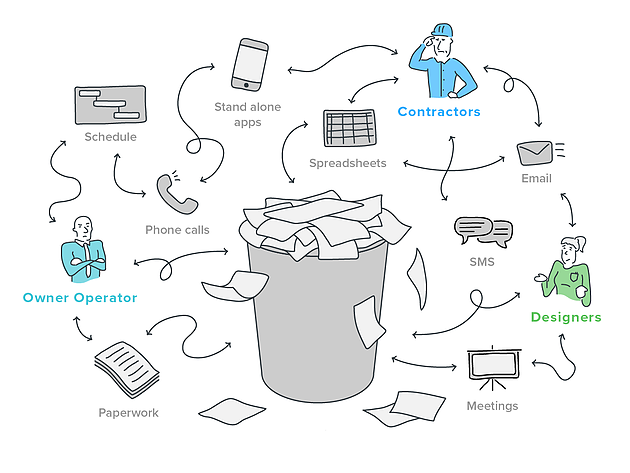Elevate Your Project Management: Construction Document Management Tools You Need
Elevate Your Project Management: Construction Document Management Tools You Need
Blog Article
Optimizing Task Cooperation: Architect's Best Practices in Construction Record Administration
In the complex realm of building projects, the efficient management of building papers stands as a keystone for success. Among this intricacy exists a vital inquiry: just how can engineers streamline collaboration processes to enhance project outcomes?
Leveraging Cloud-Based Systems
By transitioning from conventional paper-based systems to shadow options, architects can simplify partnership, improve record access, and improve overall task effectiveness. This accessibility advertises smooth communication and sychronisation among job stakeholders, leading to less mistakes and hold-ups in the building and construction procedure.
Furthermore, cloud-based platforms provide a secure environment for storing sensitive task information, using encryption, regular back-ups, and customer consent settings to secure information integrity. Engineers can also take advantage of the scalability of cloud remedies, enabling them to readjust storage space capacity and capability based upon project demands. Overall, leveraging cloud-based platforms encourages architects to enhance their construction paper administration processes, driving higher cooperation, efficiency, and success in their jobs.
Implementing Version Control Solution
Having actually developed the benefits of cloud-based platforms in building paper monitoring, architects can currently boost their document control processes by executing Version Control Solution. Variation Control Solution (VCS) are essential tools that track adjustments in documents, ensuring that team members are always working with the most current and most precise info. By executing VCS, designers can preserve a centralized repository where all project files are kept, allowing seamless partnership while decreasing the threat of mistakes and variation disputes.
This function is specifically useful in construction tasks where design models and adjustments are usual. This openness not only boosts accountability yet also assists in dealing with disagreements or inconsistencies that might develop during the job lifecycle.
Developing Communication Methods
To guarantee reliable and efficient project sychronisation, engineers should develop clear and robust interaction methods within their building record management processes. Interaction methods define the techniques, regularity, and channels where employee exchange details, updates, and responses. One vital facet of establishing these protocols is figuring out a central communication platform where all project-related conversations and record sharing can take place. This platform might be a job monitoring software program, e-mail threads, or cloud-based storage services. By setting guidelines on exactly how info is shared and just how employee connect with each various other, architects can improve the circulation of information and stop miscommunications or hold-ups in the construction process.
Furthermore, interaction procedures ought to likewise consist of standards on just how to manage disputes, adjustment orders, and urgent problems that may arise during the job lifecycle. Establishing an organized technique to communication guarantees that all stakeholders get on the very same page, promotes openness, and inevitably adds to the successful conclusion of the building and construction job.
Utilizing BIM Software Program for Sychronisation
BIM software program plays a navigate to these guys crucial duty in improving coordination amongst project employee in the construction market. Building Details Modeling (BIM) assists in partnership by providing a central system where designers, designers, service providers, and other stakeholders can function together in a coordinated fashion. With BIM software program, job individuals can access and update a common model that contains in-depth information about the structure design, building and construction components, and job timetables.

Moreover, BIM software enables real-time partnership and communication among employee, no matter of their physical place. Through cloud-based BIM systems, project stakeholders can access the most recent task information, track changes, and make educated decisions without delay. In general, leveraging BIM software for sychronisation boosts job performance, efficiency, and inevitably causes effective job end results.
Ensuring Data Security and Conformity
In the realm of building paper monitoring, securing data honesty and guaranteeing governing compliance are vital factors to consider for architects and other job stakeholders. Architects need to execute durable protection measures to protect delicate job information from unauthorized accessibility or violations.

Verdict
Finally, architects can optimize job cooperation in building record management by leveraging cloud-based systems, implementing version Home Page control systems, developing communication procedures, making use of BIM software application for control, and guaranteeing information protection and compliance. These finest techniques help improve the building and construction procedure, boost communication amongst task stakeholders, and enhance effectiveness in task delivery. By complying with these standards, engineers can efficiently handle building and construction documents and help with effective task end results.
Through BIM software, job individuals can access and upgrade a common design that includes comprehensive info concerning the structure design, construction components, and project routines.
With cloud-based BIM platforms, job stakeholders can access the most current job info, track modifications, and make notified decisions immediately - construction document management. Generally, leveraging BIM software application for sychronisation improves project efficiency, productivity, and ultimately leads to effective task end results
In final thought, designers can optimize project collaboration in building and construction paper administration by leveraging cloud-based platforms, executing version control systems, establishing interaction methods, using BIM software application for coordination, and ensuring information safety and security and conformity. These finest techniques assist simplify the building procedure, boost interaction among project stakeholders, and boost performance in job delivery.
Report this page